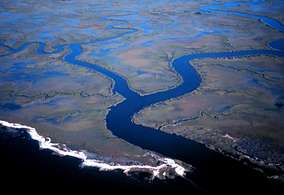How widespread is the problem of contaminated sediments?
Concerns about sediment contamination go back to the 1980s. In 1989, the Director of the Office of Oceanography and Marine Assessment of the National Oceanic and Atmospheric Administration (NOAA) testified before Congress that there was a “truly national . . . problem of toxic contamination of sediment, fish, and shellfish throughout the coastal waters of the United States.” This conclusion was drawn from sampling more than 200 estuarine and coastal areas along the Pacific and Atlantic Oceans, and in the Gulf of Mexico (Ehler, 1989).
The NOAA diagnosis was further corroborated by the National Research Council (NRC), which also released a report on contaminated marine sediments in 1989 (NRC, 1989). After examining data from public agencies and private research centers, the NRC concluded that:
“Sediment contamination is widespread throughout U.S. coastal waters and is potentially far reaching in its environmental and public health significance.”

Estuaries and nearshore coastal areas are most likely to have and be affected by contaminated sediments. Ocean areas receive contaminated sediments by natural transport of sediments in river plumes and anthropogenic ocean dumping activities. Estimates of the extent of contaminated sediments in the United States vary. One study (Summers 2001) found that 44% of estuarine sediments on the U.S. Atlantic and Gulf coasts supported benthic communities in marginal or degraded conditions. These marginally degraded or degraded biological communities were less diverse than expected, were populated by pollution-tolerant species, and contained fewer than expected pollution-sensitive species. photo: coastal South Carolina. courtesy of National Oceanic Atmospheric Administration (NOAA) National Estuarine Research Reserve Collection.
It was in response to these studies that Congress passed the legislation in 1992 that directed EPA to conduct the comprehensive national survey of data on aquatic sediment quality in the United States. The 1997 EPA report was entitled, The Incidence And Severity of Sediment Contamination In Surface Waters of the United States, Volume 1: National Sediment Quality Survey (USEPA, 1997.) Along with identifying the 96 watersheds in which sediment contamination was a concern, the Survey also reported that more than 230 different chemicals or chemical groups were found at 21,000 sampling stations around the country. The chemicals thought to be causing probable or possible harm numbered 97, and of those, the big offenders were PCBs, mercury and other metals, DDT and other pesticides, and PAHs. Some of these chemicals can be viewed as “legacy” contaminants, such as PCBs, dioxins and DDT. Others are emerging contaminants, such as polycyclic aromatic hydrocarbons, or PAHs. Even the “legacy” toxics can, and do, continue to appear even though their production is banned. For toxics such as hydrocarbons, the production is increasing, as is their appearance in sediments.
To assess the extent of sediment contamination nation-wide, the EPA analyzed data from more than 21,000 sediment sampling stations. It found that 75% of the stations had “probable” or “possible but expected infrequently” adverse effects from the level of contamination in the sediments. It identified 96 watersheds that contain “areas of probable concern for sediment contamination.” According to EPA:
“[These watersheds] are sufficiently contaminated with toxic pollutants to pose potential risks to people who eat fish from them and to fish and wildlife . . . Every state has some sediment contamination . . . . Sites where the highest levels of sediment contamination were measured tend to cluster around larger urban areas and industrial centers and in regions affected by agricultural and urban runoff.” (USEPA, 1997.)
The EPA data therefore indicate that cities, industrial areas, farming communities, and areas around cities experience sediment contamination: in other words, a cross-section of America. The 96 watersheds of concern include large tracts of waters, such as Cape Cod, Narragansett Bay, Southern Long Island, Puget Sound, and San Francisco Bay.
A recent study by Long (2000) of estuarine sediments nationwide concluded that 26 to 27% of sediment samples had chemical concentrations high enough to warrant concern for potential toxicological effects. The study also concluded that slightly degraded conditions were much more widespread than acutely toxic conditions; specifically, 42 to 48% of the sampling stations had slightly elevated chemical concentrations and 43 to 60% of the estuarine areas sampled showed adverse biological effects based on sensitive sublethal bioassays. A recent review by Summers (2001) found that 40, 45, and 75% of estuarine sediments on the United States Atlantic and Gulf coasts are enriched with metals, PCBs, and pesticides, respectively, from anthropogenic sources. As more surveys are completed by state and federal agencies and researchers, more hotspots and areal extents of sediment contamination are likely to be identified.
The problem of sediment contamination and effects to benthic bottom communities is not localized to urban estuaries because, by their very nature, sediments are mobile. The sediments arrived to estuaries by deposition from land, and they move out of the estuaries to settle further offshore by processes such as river plume movement or dredging/dumping activities. Urban areas are usually found near large estuaries with major rivers. These river plumes can have far reaching effects into the ocean. For example, researchers estimate that the 1995 Salinas River flood carried as much 3 million tons of sediment (and associated nutrients and toxic contaminants) down Monterey Canyon (Perkins, 2001). Another consequence of urban centers near large estuaries is that there is extreme pressure for dredging to deepen and maintain channels. Dredging and ocean dumping activities in particular move sediment contamination directly to offshore areas.
An example of the risk to ocean benthic systems from contaminated sediments is the Historic Area Remediation Site (HARS) in the NY Bight.


 Donate
Donate